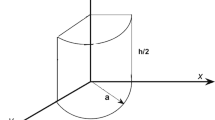Abstract
Several numerical methods have been developed for finding the minimum zone of a cylinder. This paper presents a combinatorial method termed the Minimum Shell for cylindricity evaluation. For a given set of measured data points, the method efficiently searches for the six points that determine the minimum zone of cylindricity. This method is self-contained, without the requirement of mathematical programming software support, and is equal to or superior to other methods of evaluating cylindricity in terms of accuracy, efficiency, and simplicity. Computational results are given.
Similar content being viewed by others
References
Waldele, F., Bittner, B., Busch, K., Drieschner, R. and Elligsen, R. (1993) Metrology standards news. Precision Engineering, 15, 121–123.
Anon (1994) American National Standards Institute: Dimensioning and Tolerancing for Engineering Drawings, ANSI Standard Y14.5M, ASME, New York.
Anon (1994) American National Standards Institute: Mathematical Definition of Dimensioning and Tolerancing Principles, ANSI Standard Y14.5.1M, ASME, New York.
Whitehouse, D.J. (1994) Handbook of Surface Metrology, Institute of Physics Publishing, London.
Anon (1972) American National Standards Institute: Measurement of Out-of-Roundness, ANSI Standard B89.3.1, ASME, New York.
Carr, K. and Ferreira, P. (1995) Verification of form tolerances, part II: cylindricity and straightness of a median line. Precision Engineering, 17, 144–156.
Foster, L.W. (1994) Geometrics III, Addison-Wesley Publishing, New York, NY.
Shunmugam, M.S. (1986) On assessment of geometric errors. International Journal of Production Research, 24, 413–425.
Goto, M. and Iizuka, K. (1997) An analysis of the relation between the minimum zone deviation and the least squares deviation in circularity and cylindricity, in Proceedings of the ICPE-1997, New Delhi, India.
Murthy, T.S.R. (1982) A comparison of di.erent algorithms for cylindricity evaluation. International Journal of Machine Tool Design and Research, 22, 283–292.
Murthy, T.S.R. and Abdin, S.Z. (1980) Minimum zone evaluation of surfaces. International Journal of Machine Tool Design and Research, 20, 123–136.
Nelder, J.A. and Mead, R. (1965) A simplex method for function minimization. Journal of Computers, 7, 308–313.
Tsukada, T. and Kanada, T. (1985) Minimum zone evaluation of cylindricity deviation by some optimization techniques. Bulletin of the Japanese Society of Precision Engineering, 19, 18–23.
Tang, S.Y.(1995) Minimum zone methods for evaluating standard form tolerances in engineering metrology. Masters' thesis, Industrial Engineering Dept., North Carolina State University, Raleigh, NC 27695–7906.
Houle, M. E. and Toussaint, G.T. (1988) Computing the width of a set. IEEE Transactions on Pattern Analysis and Machine Intelligence, 10, 761–765.
Roy, U. and Zhang, X. (1992) Establishment of a pair of concentric circles with the minimum radial separation for assessing roundness error. Computer-Aided Design, 24, 161- 168.
Roy, U. (1993) Computational methodologies for computer aided inspection, in Proceedings of the 2nd Industrial Engineering Research Conference, Los Angeles, CA, pp. 466–470.
Anthony, G.T. et al. (1993) Chebyshev best-fit geometric elements. NPL Report DITC 221/93.
Anthony, G.T., Anthony, H.M. and Kok, J. (1996) Reference software for finding Chebyshev best-fit geometric elements. Precision Engineering, 19, 28–36.
Author information
Authors and Affiliations
Rights and permissions
About this article
Cite this article
Hodgson, T.J., Kay, M.G., Mittal, R.O. et al. Evaluation of cylindricity using combinatorics. IIE Transactions 31, 39–47 (1999). https://doi.org/10.1023/A:1007572617551
Issue Date:
DOI: https://doi.org/10.1023/A:1007572617551




